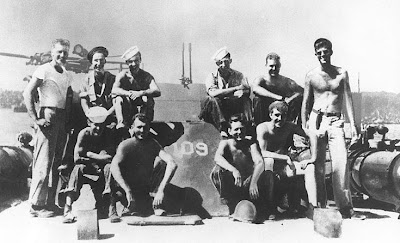 |
| The PT-109 crew, Kennedy at far right. US National Archives photo. |
When John F. Kennedy was elected President of the United States in 1960, he became the first Navy veteran to reach the country’s highest office. Many soldiers had been elected president, including George Washington and Kennedy’s predecessor Dwight Eisenhower, but Kennedy was the first sailor and, with the exception of Ronald Reagan, every president for the next 32 years would be a Navy veteran.
Kennedy was already in the Navy when the Japanese attacked Pearl Harbor. Back problems had kept him out of the Army, but his father’s influence got him a commission and a desk job in the Navy. With the coming of the war, Kennedy trained for service aboard patrol torpedo (PT) boats, and went on to serve in Panama, then the South Pacific.
The events of August 2, 1943 have become part of the Kennedy legend, and helped catapult him into international fame and, eventually, the White House. While on night patrol in the Solomon Islands, Kennedy’s PT boat, the PT-109, was cut in half after being rammed by a Japanese destroyer. Kennedy rallied his men and led them to a nearby island, towing his wounded second-in-command’s life jacket with his teeth. Except for the two crewmen lost in the collision, all were rescued a few days later.
Kennedy’s heroism in dealing with the loss of his boat was celebrated, but many questioned his judgment in getting the PT-109 into trouble in the first place. The boat’s radio was unmanned while many crewmembers rested, thus Kennedy was unaware of the larger situation that night. Kennedy’s handling of the PT-109 may have caused it to stall, resulting in the collision. Kennedy, while a popular commander, may have been a sloppy ship captain.
Whatever the truth, the PT-109 legend was a centerpiece of Kennedy’s political campaigns after the war. His actions after the PT-109 collision had earned him the lifelong loyalty of his crew: many appeared on a float in Kennedy’s inaugural parade next to a replica of the boat.
As President, Kennedy believed in a strong Navy. The now-famous SEAL teams were started during his administration. The Navy was key in his handling of the 1962 Cuban Missile Crisis. He said in a 1963 speech on board the aircraft carrier Kitty Hawk that
Events of October 1962 indicated, as they had all through history, that control of the sea means security. Control of the seas can mean peace. Control of the seas can mean victory. The United States must control the seas if it is to protect your security...."
This is the second in a series of posts about presidents and near-presidents who had a nautical background, in honor of the US election this year.
Related Posts
Related Articles
Department of the Navy: Naval History & Heritage Command: Lieutenant John F. Kennedy, USN.
Historynet.com: John F. Kennedy's PT-109 Disaster
John F. Kennedy Presidential Library and Muesum: Remarks at the US Naval Academy, August 1 1963












JFK FTW FTW FTW FTW!!!!
ReplyDelete